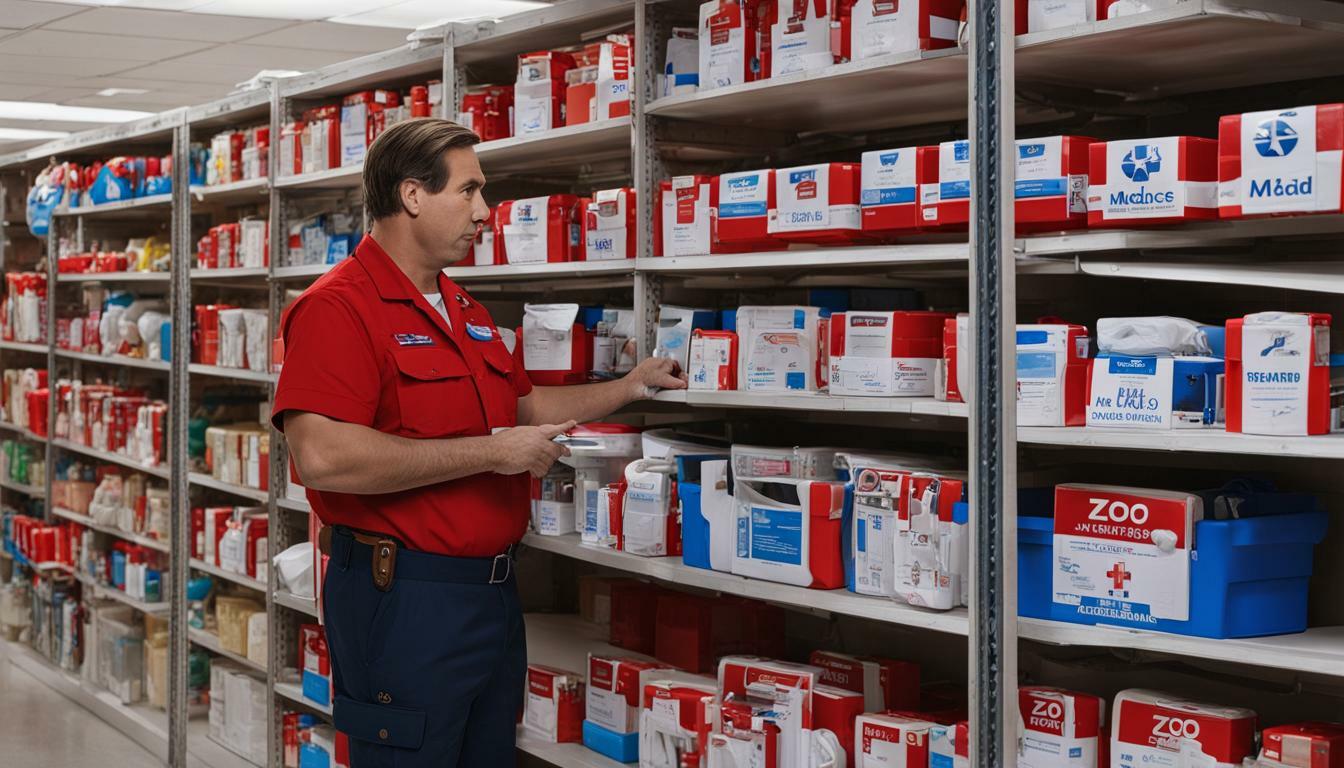Working as a zookeeper can be an incredibly rewarding profession, but it also comes with its fair share of risks. One of the most important precautions that zookeepers must take is ensuring they have access to first aid kits to handle any injuries or emergencies that may occur during animal interactions.
Zookeepers in the UK work with a wide range of animals, from small birds to large carnivores, and each species presents its own unique set of challenges and potential dangers. It’s crucial that zookeepers have the proper training and equipment, including first aid kits, to ensure their safety and the well-being of the animals they work with.
First aid kits for zookeepers should be specifically tailored to their job requirements, including items such as bandages of various sizes, antiseptic wipes, plasters, gloves, and emergency medications. In addition to having the necessary supplies, it’s important that zookeepers know how to use them effectively and efficiently in emergency situations.
Preventing injuries and accidents in the first place is the best way to ensure the safety of both zookeepers and the animals they work with. Zookeepers should follow strict safety protocols when interacting with animals, including proper animal handling techniques and the use of protective gear when necessary.
In the following sections, we will explore the importance of first aid kits for zookeepers, potential risks of animal interactions, essential first aid supplies, emergency preparedness, safety training, proper animal handling techniques, dealing with common zookeeper injuries, resources for health and safety, and the crucial role of first aid kits in zookeeper safety.
Key Takeaways:
- Zookeepers must take necessary precautions when interacting with animals to ensure their own safety and the well-being of the animals.
- First aid kits tailored to the zookeeper’s job requirements are essential for handling injuries and emergencies.
- Preventing injuries and accidents through proper safety protocols is crucial.
Understanding the Risks of Animal Interactions
Working as a zookeeper can be an exciting and rewarding career, but it also comes with its fair share of risks. Interacting with animals is inherently unpredictable, and even the most experienced zookeepers can face unexpected situations. Therefore, taking necessary precautions to ensure zookeeper safety is crucial.
Animal interaction precautions are essential to prevent zookeeper injury and maintain their health and safety. Zookeepers must be aware of the potential risks associated with their job and take steps to minimize them. Some of the risks associated with animal interactions include bites, scratches, being knocked over, and exposure to zoonotic diseases.
To prevent these risks, zookeepers must be trained in animal handling safety and understand the behaviour of the animals they work with. They should always use appropriate personal protective equipment, such as gloves and safety glasses, and avoid approaching unfamiliar animals without proper training and assistance. Additionally, they should never enter an enclosure without proper safety protocols in place and should always have a colleague present.
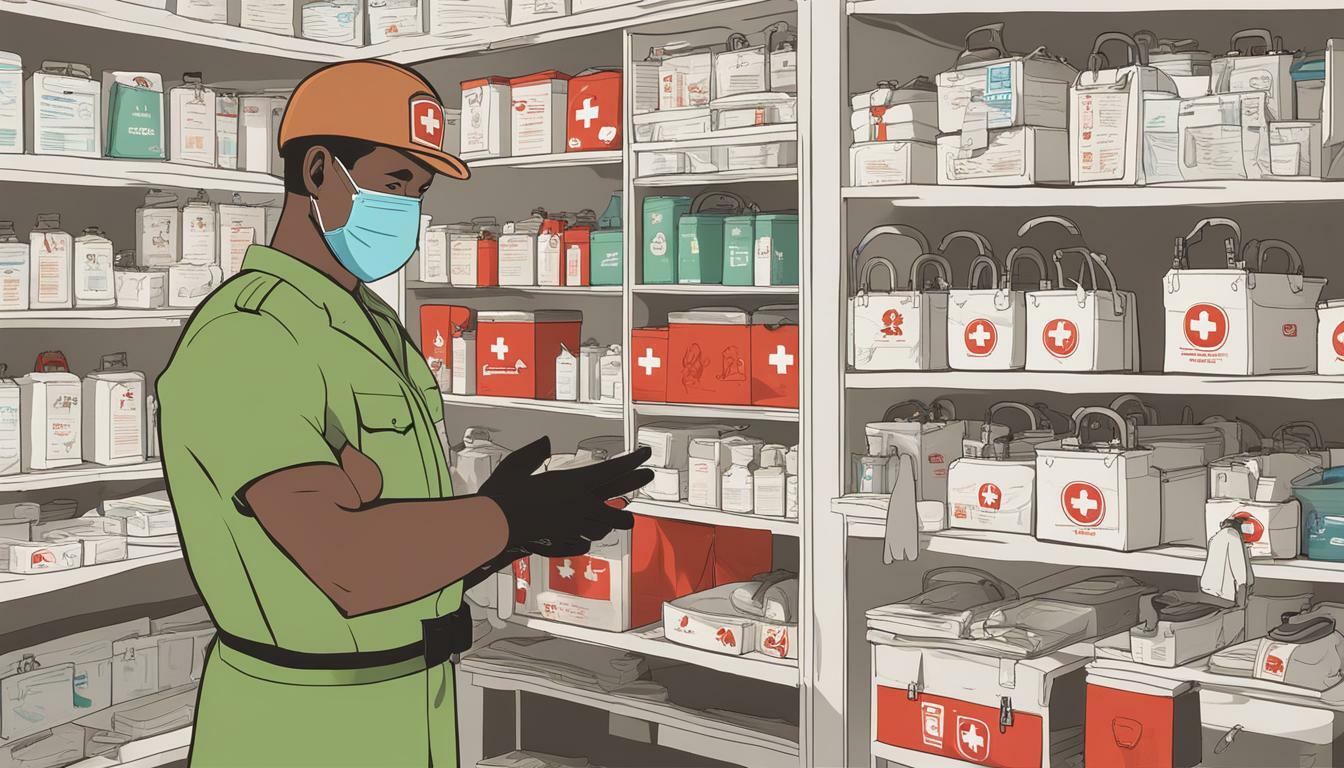
Zookeepers must also know how to recognise signs of distress in an animal and understand how to respond to it. By paying attention to an animal’s body language, zookeepers can identify when they may be uncomfortable, in pain or agitated. They should then remove themselves from the situation and seek assistance from a colleague or supervisor.
Finally, zookeepers must be prepared for emergencies and know how to respond in case of an accident. They should receive training in first aid, and have access to first aid kits and medical supplies. Being prepared can make all the difference in the event of an emergency.
Essential First Aid Supplies for Zookeepers
Zookeepers interact with animals on a daily basis and are therefore at increased risk of injuries and accidents. It is therefore essential that they are equipped with adequate first aid supplies to treat any injuries should they occur. In this section, we will outline the essential first aid supplies that zookeepers should have in their kits to handle any injuries or emergencies that may occur during their work.
The first aid kit for zookeepers should contain items that are specific to their needs. These can include:
| Item | Usage |
|---|---|
| Antiseptic solution and wipes | To clean and disinfect wounds |
| Bandages, gauze and tape | To dress wounds and stop bleeding |
| Instant cold pack | To reduce swelling and pain of injuries |
| Saline solution | To rinse eyes or wounds that may have been contaminated |
| Disposable gloves | To prevent infection and cross-contamination |
| Tweezers and scissors | To remove foreign objects and cut bandages |
| Painkillers | To relieve pain and discomfort |
It is important to regularly check the first aid kit and replace any expired or used items. Zookeepers should also periodically review the contents of their first aid kit with their supervisor to ensure that they are adequately equipped to handle any potential injuries or emergencies.
Additionally, zookeepers may want to consider carrying a more extensive medical kit for more severe injuries or emergencies. This could include items such as a trauma kit, oxygen mask and a defibrillator. It is important to note that these kits require specialized training to use and should only be used by those who have received proper training.
By having the proper first aid supplies on hand, zookeepers can quickly and effectively treat injuries and emergencies, minimizing the risk of further complications. It is therefore essential for zookeepers to have a well-stocked and properly maintained first aid kit at all times.
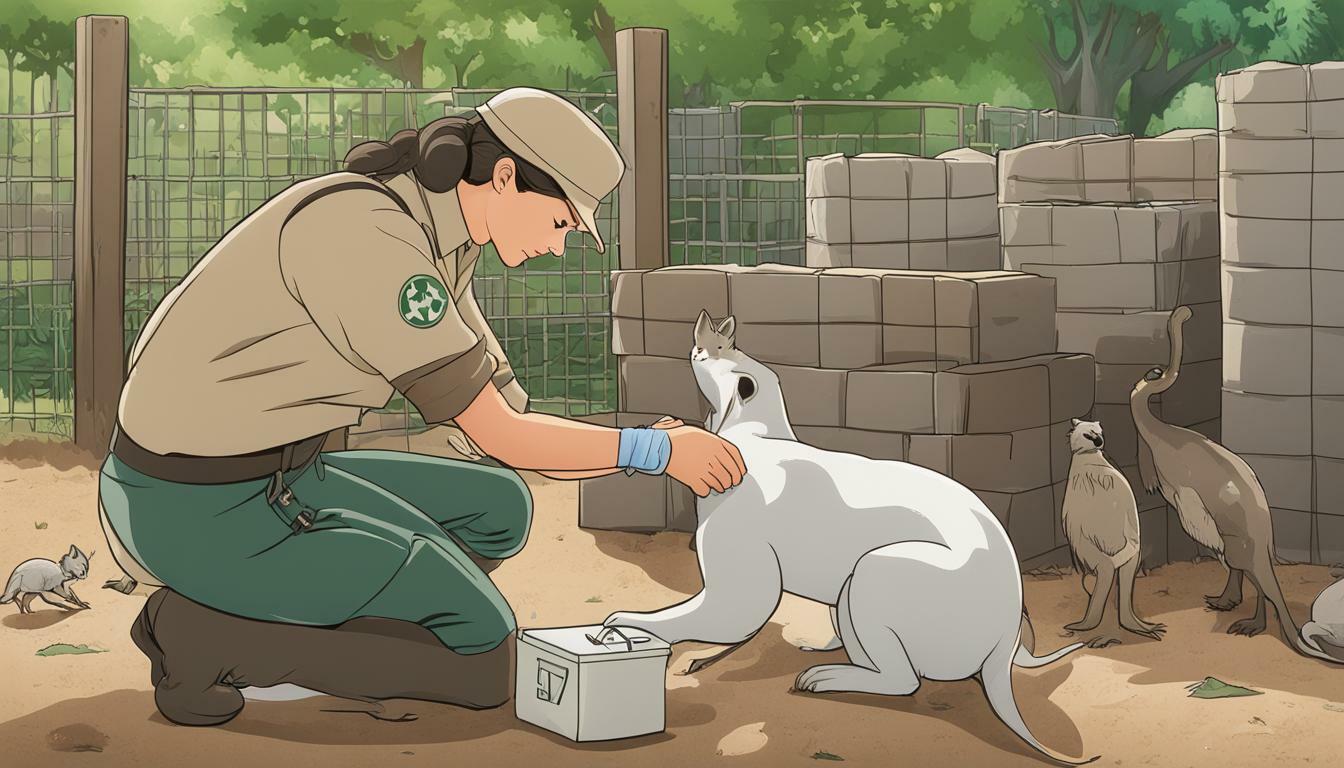
Preparing for Animal Handling Emergencies
Emergency preparedness is crucial for zookeepers who handle animals on a daily basis. It is important for them to be able to respond quickly and effectively in case of an emergency. This involves having the right safety gear on hand and knowing how to react in different situations.
Zookeepers should always wear appropriate safety gear when interacting with animals, including gloves, safety glasses, and protective clothing. In addition, they should have access to first aid kits that contain essential supplies such as bandages, antiseptics, and pain relievers. These kits should be easily accessible and regularly checked to ensure that they are fully stocked and up-to-date.
Zookeepers should also be trained in animal handling safety and emergency procedures. It is important for them to know how to safely restrain animals and how to respond in case of an attack or escape. Additionally, they should be aware of common injuries that can occur during animal interactions, such as bites and scratches, and how to treat them using their first aid kits.
Preparing for Animal Handling Emergencies
In case of an emergency, zookeepers should have a plan in place to ensure the safety of both themselves and the animals. This plan should include procedures for evacuating the area, contacting emergency services, and providing first aid to any injured individuals.
Zookeepers should also be familiar with the layout of the zoo and the locations of emergency exits and first aid stations. They should be able to quickly assess the situation and determine the best course of action.
| Zookeeper Safety Gear | Animal Handling Safety | Zookeeper Emergency Preparedness |
|---|---|---|
|
|
|

By taking these precautions and being prepared for emergencies, zookeepers can minimize the risk of injury and ensure the safety of both themselves and the animals they work with.
Safety Training for Zookeepers
Zookeeping can be a challenging and risky profession, requiring a significant amount of training and preparation to ensure that both the animals and the zookeepers are safe. Safety training is a crucial aspect of zookeeping that can’t be underestimated. Zookeepers who receive proper training are better equipped to handle emergencies, understand animal behaviour, and take necessary precautions to prevent injuries.
There are several types of safety training programs for zookeepers to choose from, including both online and in-person options. Many of these programs cover a wide range of topics such as animal handling safety, zoonotic diseases, and first aid procedures. Some programs are even tailored to specific species, such as big cats or primates, to help zookeepers understand the unique behaviours and characteristics of those animals.
It is important for zookeepers to stay up-to-date with their training as new information and techniques become available. Safety training should be ongoing to ensure that zookeepers are always equipped with the latest knowledge and skills to handle any situation that may arise.
Zookeepers should also take individual steps to maintain their own health and safety. This includes being mindful of the physical demands of the job and taking necessary precautions to prevent injuries. Adequate rest, proper nutrition, and regular exercise can help zookeepers stay healthy and sharp on the job.

Overall, safety training is critical for zookeepers to prevent injuries, maintain their own health and safety, and ensure the well-being of the animals they care for. By staying up-to-date with new information and techniques, zookeepers can stay ahead of potential risks and handle any emergencies that may arise.
Proper Animal Handling Techniques
Zookeepers must follow proper animal handling techniques to ensure the safety and well-being of both themselves and the animals. There are several precautions that zookeepers should consider when handling animals, including:
- Understanding the animal’s behaviour and body language
- Approaching the animal calmly and slowly
- Avoiding direct eye contact, especially with primates and big cats
- Avoiding sudden movements or loud noises
- Keeping a safe distance from the animal, especially if it appears agitated or stressed
- Using appropriate tools and equipment to handle the animal, such as gloves or nets
- Working in teams when handling larger animals
Following these precautions can help minimise the risk of injuries or incidents when handling animals. It is also important for zookeepers to receive proper training in animal behaviour, as well as first aid and emergency response.
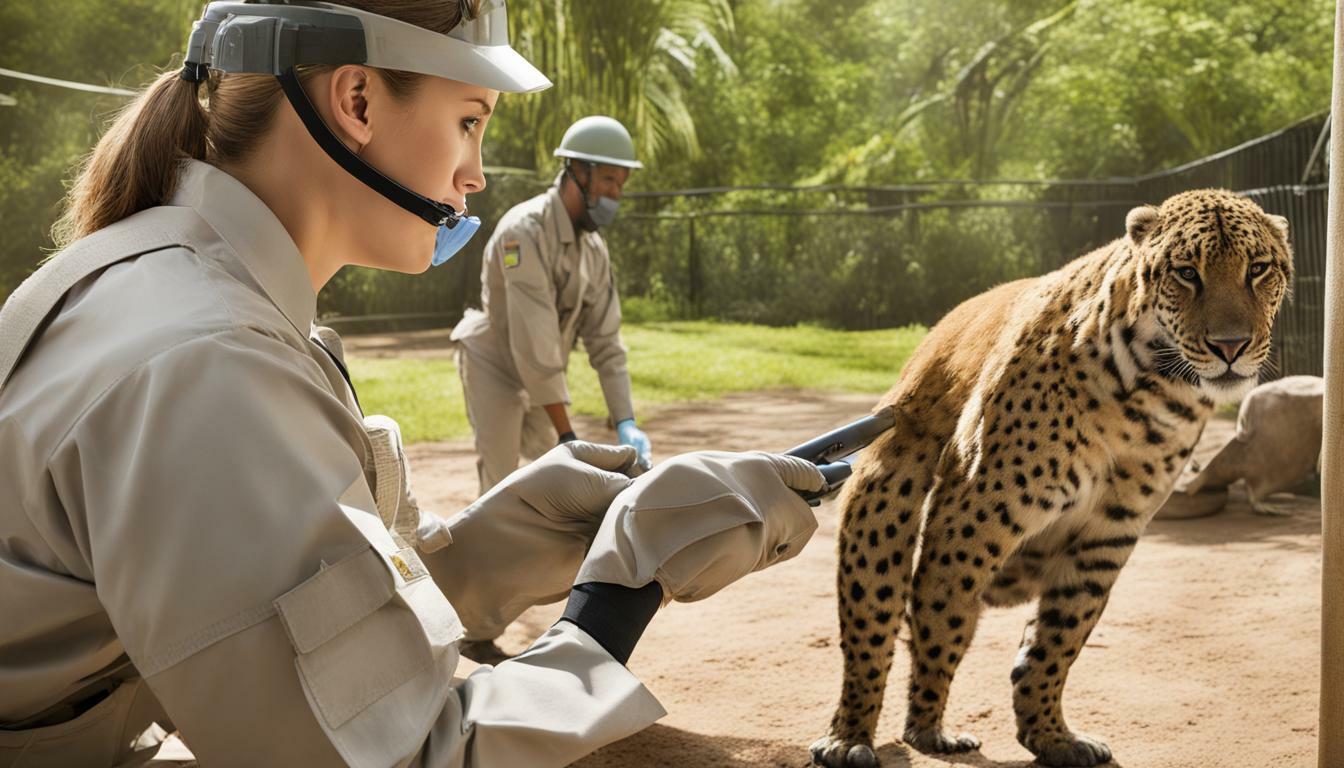
In addition to taking precautions, zookeepers should also be aware of their own physical limitations when handling animals. Lifting or restraining heavy animals can cause strains or injuries if not done properly. Zookeepers should use proper lifting techniques and consider using lifting aids when necessary.
Proper Lifting Technique:
| Step | Description |
|---|---|
| Step 1 | Keep your feet shoulder-width apart and bend your knees. |
| Step 2 | Keep your back straight and grasp the animal firmly. |
| Step 3 | Lift using your legs and avoid straining your back. |
| Step 4 | Hold the animal close to your body and avoid twisting your back while carrying it. |
By following proper animal handling techniques and lifting methods, zookeepers can minimise the risk of injuries and ensure the safety of both themselves and the animals they care for.
Dealing with Common Zookeeper Injuries
Zookeepers face a variety of risks and potential injuries when working with animals. While prevention is always the best course of action, injuries can still occur despite taking necessary precautions. In this section, we will address some common injuries that zookeepers may encounter and provide guidance on how to handle them using their first aid kits.
Scratches and Bites
Scratches and bites are some of the most common injuries that zookeepers may face. These injuries can range from minor to severe and can become infected if left untreated. If you are scratched or bitten by an animal, the first step is to wash the area thoroughly with soap and water. Apply pressure to a bleeding wound with a clean cloth and use a sterile adhesive bandage to cover it. If the injury is severe, seek medical attention immediately.

Sprains and Strains
Due to the physical demands of animal handling, zookeepers are at risk of experiencing sprains and strains. These injuries can occur when lifting or carrying heavy animals or when performing physical tasks for extended periods of time. If you experience a sprain or strain, RICE (Rest, Ice, Compression, Elevation) is the recommended treatment. Rest the affected area, apply ice or a cold compress, wrap the area with a compression bandage, and elevate the affected limb. If the pain persists or is severe, seek medical attention.
Eye Injuries
Zookeepers working with birds or other animals with sharp beaks or claws are at risk of eye injuries. If you experience an eye injury, do not rub or touch the affected eye, as this can cause further damage. Instead, flush the eye with clean water for at least 15 minutes and seek medical attention immediately.
By taking necessary precautions and having a well-stocked first aid kit on hand, zookeepers can minimize the risk of injuries and handle any emergencies that may arise.
Resources for Zookeeper Health and Safety
Ensuring the health and safety of zookeepers is of paramount importance, and there are several organizations and resources available to provide guidance and support.
The British and Irish Association of Zoos and Aquariums (BIAZA) is the professional body representing the zoo and aquarium community in the UK and Ireland. BIAZA offers a range of resources and training opportunities for zookeepers to improve their knowledge and skills in animal handling safety.
The Health and Safety Executive (HSE) is the UK government agency responsible for the regulation and enforcement of workplace health and safety. Zookeepers can access a wealth of information on the HSE website, including guidance on animal handling, risk assessment, and first aid.
The Royal Society for the Prevention of Cruelty to Animals (RSPCA) is a UK-based animal welfare charity that works to promote animal welfare and prevent cruelty. The RSPCA provides guidance on handling animals in captivity and offers training programs for zookeepers.
Zookeeper safety is a top priority for these organizations, and they offer a wealth of resources and support to ensure the well-being of zookeepers in the UK.
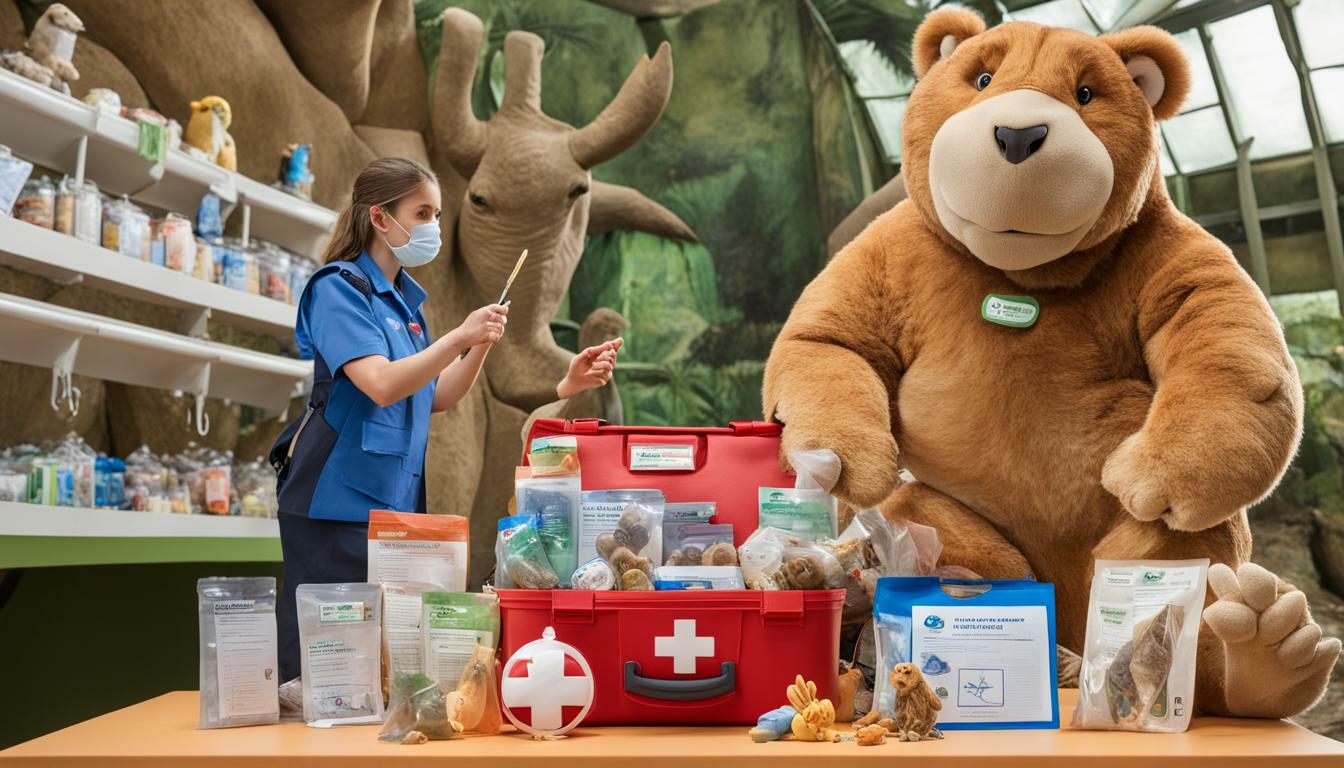
The Role of First Aid Kits in Zookeeper Safety
First aid kits are an integral part of zookeeper safety, providing vital supplies for injuries and emergencies on the job. Zookeeper safety can be a challenging task due to the nature of working with animals, but ensuring that first aid supplies are always accessible can be a lifesaver in critical situations.
Zookeepers should carry a first aid kit with them at all times when interacting with animals. These kits should be well-stocked with essential supplies such as bandages, gauze pads, antiseptic wipes, tweezers, scissors, and disposable gloves. In addition, it’s crucial to have a manual on first aid procedures on hand to help deal with any injuries or emergencies that may arise.
| Essential First Aid Supplies for Zookeepers |
|---|
| Bandages |
| Gauze pads |
| Antiseptic wipes |
| Tweezers |
| Scissors |
| Disposable gloves |
Injuries can happen unexpectedly, and proper first aid preparedness can be the difference between a minor injury and a serious one. Therefore, zookeepers must be proactive in ensuring that their first aid kits are well-stocked and up-to-date.
Zookeepers can also take a proactive approach to emergency preparedness by regularly reviewing their first aid kits and procedures. It is recommended to review the contents of your first aid kit at least once every three months to ensure that everything is still in working order and up-to-date. In addition, it is essential to maintain an emergency plan, which should include procedures for dealing with animal handling accidents and injuries.
Finally, proper safety training for zookeepers is also crucial to minimizing the risk of injuries and emergencies in the workplace. Zoos and other animal management facilities should provide comprehensive safety training to all zookeepers and support staff to ensure that everyone is aware of the potential risks and knows how to deal with them. By combining first aid preparedness, proper emergency planning, and safety training, zookeepers can maintain their health and safety while working with animals.
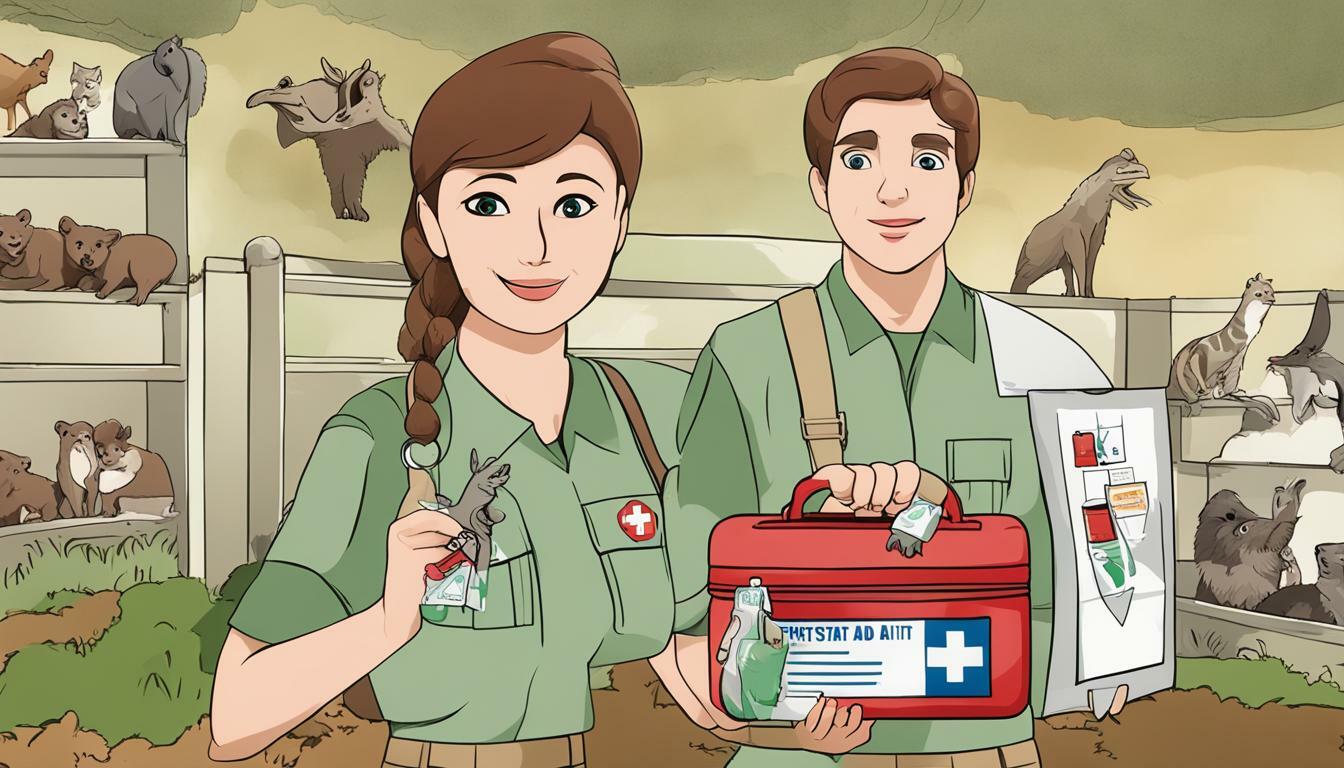
Conclusion
As we have seen, first aid kits are an essential component of the safety gear that zookeepers must have on hand when working with animals. The risks of animal interactions are numerous and can lead to serious injuries or emergencies if not handled properly.
By taking the necessary precautions, following proper animal handling techniques and having access to essential medical supplies, zookeepers can minimize these risks and ensure the safety and well-being of both themselves and the animals they care for.
Remember:
When it comes to zookeeper safety, prevention is key. Make sure to always have a well-stocked first aid kit on hand, undergo regular safety training, and follow proper animal handling techniques at all times.
If you encounter any injuries or emergencies during your interactions with animals, don’t hesitate to use your first aid kit and seek medical attention if necessary.
Lastly, remember that there are resources and organizations available to help you maintain your health and safety as a zookeeper. Don’t hesitate to reach out for additional support and guidance.
Stay safe out there!
